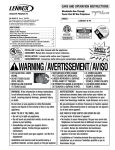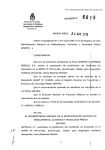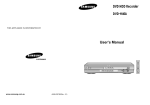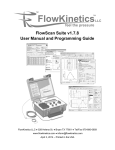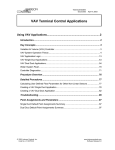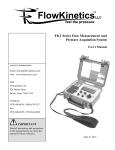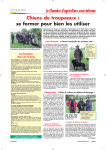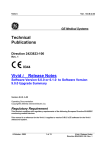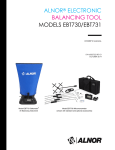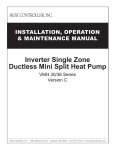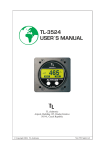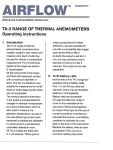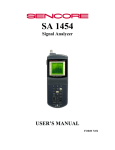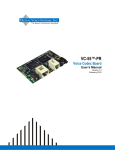Download FKS 1DP-PBM Manual
Transcript
FKS 1DP-PBM Multi-Function Meter Pressure, Velocity & Flow User’s Manual Contact Information Email: [email protected] Web: www.flowkinetics.com Mail: FlowKinetics LLC 528 Helena Street Bryan, Texas 77801 USA Telephone: (979) 680-0659 (888) 670-1927 Fax: (979) 680-0659 (979) 846-2808 IMPORTANT Read all instructions and precautions in this manual before use. Keep this manual for future reference. Nov 4, 2014 FKS 1DP- PBM User Manual - Copyright © 2014 FlowKinetics LLC, All Rights Reserved Table of Contents Page Limitations Of Usage And Cautions ......................................................... 5 Warranty ................................................................................................... 5 Unpacking / Parts List .............................................................................. 6 Overview / Features ................................................................................. 7 Description of Controls & Display ............................................................ 8 General Operation:................................................................................... 9 Q: How Do I Insert Batteries / Use Wall Power? ...............................................9 Q: How Do I Connect the Tubing? .....................................................................9 Q: How Do I Switch the Unit On (and Off)? .......................................................9 Q: How Do I Adjust the Screen Contrast? .......................................................10 Q: How Do I Know if the Batteries Need Replacement? .................................10 Q: How Do I Change the Auto-Zero Interval?..................................................10 Q: How Do I Know If the Meter is Overloaded? ..............................................11 Q: How Do I Change the Smoothing of My Data?...........................................11 Measuring Pressure ............................................................................... 13 Q: How Do I Change Units? .............................................................................13 Q: How Do I Measure the Minimum (L) and Maximum (H) Reading ..............13 Q: How Do I Reset Min/Max?...........................................................................13 2 FKS 1DP- PBM User Manual - Copyright © 2014 FlowKinetics LLC, All Rights Reserved Q: How Do I Hold or Freeze the Display? .......................................................13 Q: How Can I Estimate if the Pressure May Be Too Unsteady for Accurate Measurement? ..................................................................................................13 Q: How Do I Estimate the Uncertainty in My Pressure Measurements? ........13 Q: How Do I Store a Pressure Measurement in Memory? ..............................14 Q: How Do I Recall My Pressure Measurements From Memory? ..................14 Measuring Velocity ................................................................................. 16 Q: How Do I Change Units? .............................................................................16 Q: How Do I Measure the Minimum (L) and Maximum (H) Reading ..............16 Q: How Do I Reset Min/Max?...........................................................................16 Q: How Do I Hold or Freeze the Display? .......................................................16 Q: How Can I Estimate if the Air Velocity May Be Too Unsteady for Accurate Measurement? ..................................................................................................16 Q: What Probes can I use with the FKS 1DP-PBM? .......................................16 Q: How Do I Connect the Pitot Probe? ............................................................16 Q: How Do I Change K? ...................................................................................17 Q: How Do I Measure Standard Velocity? .......................................................17 Q: How Do I Measure Actual Velocity?............................................................18 Q: How Do I Check the Stored Values for K, Patm and T? ............................19 Q: How Do I Set K, Patm and T to Default (Standard Conditions)? ...............19 Q: How Do I Estimate the Uncertainty in My Velocity Measurements? ..........19 Q: How Do I Store a Velocity Measurement in Memory?................................20 Q: How Do I Recall My Velocity Measurements From Memory? ....................20 Measuring Flow Rate ............................................................................. 22 3 FKS 1DP- PBM User Manual - Copyright © 2014 FlowKinetics LLC, All Rights Reserved Q: How Do I Use the Pitot or S Probe Survey Routine? .................................22 Q: Can I Estimate the Uncertainty of My Flow Rate Measurement? ..............23 Q: How Do I Use Manual Logging to Perform a Survey? ................................24 The Menu System .................................................................................. 25 Data Logging and Memory Management .............................................. 26 Q: How Do I Manually Log a Reading (Store in Memory)? .............................26 Q: How Do I Configure the Meter for Automatic (Continuous) Logging? ........26 Q: How Do I Start Automatic Logging? ............................................................27 Q: How Do I Recall My Measurements From Memory? ..................................28 Q: How Do I Download Memory to a PC? .......................................................29 Q: How Do I Clear the Memory? ......................................................................30 Maintenance........................................................................................... 31 Operational Maintenance .................................................................................31 Battery Maintenance ........................................................................................31 Specifications ......................................................................................... 32 Appendix A Understanding Uncertainty ................................................. 35 Appendix B Performing a Pitot Probe Duct Traverse ............................ 37 4 FKS 1DP- PBM User Manual - Copyright © 2014 FlowKinetics LLC, All Rights Reserved Limitations Of Usage And Cautions The FKS series of instruments are not intrinsically safe, and must not be used in dangerous or hazardous areas. Servicing of these instruments incorporating battery changing must only occur in a safe area. Use of the FKS series may require working in a hazardous environment. Necessary safety precautions must be followed. FlowKineticsTM LLC’s products (including the FKS series) are not authorized for use as any component in a life support system or device or as component of an aircraft’s on board flight system. Life support systems or devices are defined as any system that can sustain, monitor or support life. The pressure transducers used by the FKS system are compatible with most non-corrosive gases, however toxic gases are not suitable, nor are liquid pressure measurements. Any attempts to service or modify or alter the product in any way, will void the warranty and will negate any right of claim against FlowKinetics TM LLC, relating to any liability in respect of the product. Warranty All of FlowKineticsTM LLC's instruments have been assembled using strictly defined and controlled procedures and tests, and are warranted against any faults in workmanship and materials for one year from the date of purchase. Liability under this warranty is limited to repair or replacement F.O.B. factory of any parts which prove to be defective within that time or repayment of the purchase price at the Seller's option provided the product has been returned, transportation prepaid, within one year from date of purchase. In no case is the Seller liable beyond replacement of product F.O.B. factory or the full purchase price. This warranty does not apply if the product or equipment is abused, altered, used at ratings above the maximum specified, used with disregard of instructions and specified operating procedures, or otherwise misused in any way. All technical advice, recommendations and services are based on technical data and information which the Seller believes to be reliable and are intended for use by persons having skill and knowledge of the application, on their own judgment. There are no implied warranties of merchantability or of fitness for a particular purpose for goods covered hereunder. In no event will the manufacturer be responsible for consequential, incidental or special damages resulting from the use of this product. Buyer's Remedies: The buyer’s exclusive and sole remedy on account of or in respect to the furnishing of non-conforming or defective material shall be to secure replacement thereof as said above. The seller shall not in any event be liable for the cost of any labor expended on any such material or for any special, direct, indirect, consequential or incidental damages to anyone or any property by reason of the fact that it shall have been non-conforming or defective. Repairs: Authorization must be obtained before shipping items to FlowKinetics™ LLC for repairs. When requesting a repair please include a detailed description of the problem with the item, date of purchase, your P.O. or reference number and our invoice number if available. 5 FKS 1DP- PBM User Manual - Copyright © 2014 FlowKinetics LLC, All Rights Reserved Unpacking / Parts List Carefully unpack your FKS 1DP-PBM meter. Ensure that there is no damage to the instrument. If any components are damaged, make a record and contact the shipper. The instrument is supplied with (some accessories are optional): Item FKS 1DP-PBM Tubing FKS Manual Cable6 SwiftLink WPA SwiftScan CD and manual Description Multi-function meter Flexible tubing for pressure connection User reference 6 ft Serial cable Software for downloading memory to PC Wall power adapter Real time software for monitoring the FKS outputs and downloading them to a PC Quantity 1 2 1 1 Download from www.flowkinetics.com Optional Optional 6 FKS 1DP- PBM User Manual - Copyright © 2014 FlowKinetics LLC, All Rights Reserved Overview / Features The FKS 1DP-PBM is a multi-function meter designed for accurate pressure, velocity and flow measurement. The meter is exceptionally easy to use due to its prompt driven user interface and intuitive functioning. Features of the PBM include: Highly configurable operation Differential, static and gauge pressure Auto-Zero (automatic) function to remove any drift (internal valve) Overload protection Metric and Imperial units Minimum & maximum reading Data hold (screen freeze) Turbulence indicator K factor Velocity (both standard and actual) Density correction Intelligent automatic damping (with user selectable averaging or smoothing) Memory / data logging (up to 10,000 Rdgs) with recall statistics Manual and automatic data logging Flow rate (using inbuilt Pitot traverse routine or memory log) Powerful statistics to estimate measurement uncertainty PC compatibility (download software included) Variable screen contrast Wall or battery power 7 FKS 1DP- PBM User Manual - Copyright © 2014 FlowKinetics LLC, All Rights Reserved Description of Controls & Display Controls of the FKS 1DP-PBM are shown below: Positive (+) pressure connection barb Negative (-) or Reference pressure connection barb On/Off button Hold/Manual log button Range control or selector External power jack plug Screen contrast control PC serial port connector Example Display Presentations for Pressure and Velocity are Shown Below: Measured pressure Maximum recorded value (H) P=1.67inH2O T H2.01 L-0.21 Turbulence indicator (appears if Pressure fluctuations > 10%) Minimum recorded value (L) Calculated velocity Maximum recorded value (H) V=6702ft/min H8291 L6231 Minimum recorded value (L) 8 FKS 1DP- PBM User Manual - Copyright © 2014 FlowKinetics LLC, All Rights Reserved General Operation: Q: How Do I Insert Batteries / Use Wall Power? Batteries: The unit uses two 9V batteries. The batteries are inserted by removing the cover located on the back of the instrument. The cover slides off. The ribbon under the batteries can be used to ease battery removal. Only use new batteries (dry Alkaline leak proof) and discard the old batteries in compliance with regulations. Wall Power: An AC adaptor power supply can be supplied with the instrument as an option. The adaptor can operate from 100V AC to 240VAC 50-60Hz supplies and provides 1100mA at 9VDC. The adaptor has the facility for easy interchange between US, European, English and Australian plugs. To use, simply insert the jack from the adapter into the jack plug on the face of the instrument (see Description of controls). It is not necessary to remove the batteries, as they are automatically disconnected. Do not attempt to use the supplied adapter as a battery charger. CAUTION: Use of any power adaptor other than that supplied (optional) with the instrument will remove any rights of claim against FlowKinetics TM LLC, relating to product liability or consequential damage against a third party and will void the warranty. If an alternative adaptor is used, its output voltage range must be regulated and within: 9V DC V ADAPTOR 12V DC If the meter is stored, or not used for over a week, the batteries must be removed. Q: How Do I Connect the Tubing? Pressure: The supplied flexible tubes attach over the barbs labeled P+ and P-. A higher pressure at port P+ than port P- will result in an indicated positive pressure. To measure static or gauge pressure, tubing can be connected to the P+ barb. An indicated positive pressure shows that the static or gauge pressure is higher than atmospheric (or the pressure at P-). Velocity: To measure velocities, the P+ port should be connected to the Total pressure port on the Pitot and the P- port connected to the Static port (see How Do I Connect the Pitot Probe?) of the Pitot probe. CAUTION: The FKS series are not suitable for use with toxic or corrosive gases or for liquid pressure measurement. The series are not approved for use in any life support application. Q: How Do I Switch the Unit On (and Off)? To switch the meter on, press in the On/Off button. You will hear and feel a click 9 FKS 1DP- PBM User Manual - Copyright © 2014 FlowKinetics LLC, All Rights Reserved indicating unit power up. To switch the unit off, press the On/Off button again. If the Range selector is set to a pressure unit, the instrument will show the meter model description and then indicate that that the instrument is performing a scheduled Auto-Zero. If the Range selector is set to a velocity unit, the meter will additionally show the stored velocity and flow settings (K, Patm and T) in both metric (kPa and C) and imperial units (inHg and F). Cycling the meter On/Off can be used to rapidly check the velocity/flow settings. The memory remaining (in number of readings) for both manual (Mem(M):xxxxRdgs) and automatic logging (Mem(A):xxxxRdgs) will be briefly displayed (for 2.5 seconds). The maximum number of readings for manual and automatic logging is 4,000 and 6,000 respectively. Q: How Do I Adjust the Screen Contrast? Screen contrast is adjusted by rotating the screen contrast knob. Only use your fingers to operate this control. Q: How Do I Know if the Batteries Need Replacement? If the battery voltage is too low, the message Low Battery will be displayed at startup. Also a B will appear at the top RHS of the display wile the meter is operating. If the battery is too drained for the meter to work properly, the message Battery Depleted will be displayed at startup and the meter will not continue until the batteries are replaced or a wall power supply is used. Q: How Do I Change the Auto-Zero Interval? The PBM meter contains a miniature solenoid valve that is used to automatically remove any offset or drift from the differential pressure transducer (without having to disconnect the meter from the pressure source). You can set the interval between zeroing from 0.2 minutes (12 seconds) to 99.9 minutes (1 hour 40 minutes). The default interval is 6 minutes 06.0. To change the interval set the Range selector to Menu. The menu will cycle through various functions. When Set Auto-Zero appears, rotate (any direction) the Range control to select it. The menu will prompt, Set Zero Rotate followed by Interval minutes. Rotate the Range selector (any direction or unit). The screen will display 00.0. The first digit will begin to blink. To increment this digit press the Hold/Log button. You can also keep the button pressed to advance rapidly. If the displayed digit increments beyond 9, it will wrap around and continue from 0. When the desired value for this digit is set, rotate the Range selector (any direction or unit). The second digit will begin to blink. Use the Hold/Log button to set the desired value; similarly for the third digit. 10 FKS 1DP- PBM User Manual - Copyright © 2014 FlowKinetics LLC, All Rights Reserved The instrument will then return to measurement mode. As an example, to set an interval of 3½ minutes, the display would be set to 03.5. To convert seconds to its decimal equivalent, divide the number of seconds by 60 and round off if necessary. If an interval of 00.0 or 00.1 is set, the unit will default to an interval of 15 seconds. The interval you set is NOT stored in memory and will not be retained after switching the unit off (to maximize battery life). Upon power up, the meter will use its default interval (6 minutes). Note: the Auto-Zero can significantly affect battery life. Using a small interval (e.g. 2 minutes or less) will reduce life, but may be needed for your application. Q: How Do I Know If the Meter is Overloaded? If the pressure rating for the transducer is exceeded, the meter will indicate on the display an overload condition (Overload). The internal solenoid valve will actuate to equalize pressure across the transducer to reduce the possibility of damage. Pressure should be relieved immediately to avoid damage. CAUTION: The maximum differential pressure that may be imposed on the transducer is 5psi, with a maximum line pressure of 10psi. Q: How Do I Change the Smoothing of My Data? The FKS 1DP-PBM meter contains sophisticated routines to process your measurements (very useful when they are unsteady or fluctuating). Two methods can be used to smooth your readings. An exponential moving average (sometimes called exponential smoothing) can be used (somewhat similar to a normal moving average) and of the form: P 2* P1 f (1 f ) P 2 (Exp. Smoothing) where P2* is the new pressure estimate (shown on the display), P2 is the latest pressure value measured from the transducer and P1 is the last pressure estimate. In the PBM meter, f is adjusted continuously (adaptive) depending on the level of fluctuation of the measured pressure. If there is little fluctuation f will be close to zero. If fluctuation is large, f has a maximum value of 0.9. Thus f is continuously adjusted by the meter (between 0 and 0.9) to provide the most stable reading. The second method that can be used is a simple averaging of readings (Average). The meter will read the output from the pressure transducer multiple times, and then average these values. The meter will continuously adjust the number of averages (from 5 to 75 averages). This operation may be noticeable, as the screen update rate may change as the meter changes (adapts) 11 FKS 1DP- PBM User Manual - Copyright © 2014 FlowKinetics LLC, All Rights Reserved the number of averages to give the best and most stable estimate of the pressure or velocity. To select the method you want set the Range selector to Menu. The menu will cycle through various functions. When Smooth/Average appears, rotate (any direction) the Range control to select it. The menu will cycle, Exp. Smoothing followed by Averaging. Rotate the Range selector (any direction or unit) when the desired method is displayed. The instrument will then return to measurement mode. The method you selected is stored in memory and will be retained after switching the unit off. For very unstable readings, the exponential smoothing may offer a more stable estimate, where the averaging will offer a quicker estimate. 12 FKS 1DP- PBM User Manual - Copyright © 2014 FlowKinetics LLC, All Rights Reserved Measuring Pressure Q: How Do I Change Units? Units are changed by rotating the Range selector knob. The knob has no stop and can rotate more than 360 degrees. Q: How Do I Measure the Minimum (L) and Maximum (H) Reading The Minimum and Maximum readings are continuously shown by the FKS meter on the second line of the display. The maximum reading is preceded by H and the minimum reading is preceded by L. No units are shown but correspond to the units displayed on the first line. Q: How Do I Reset Min/Max? To reset the Min/Max (or L-H) readings, simply change the units (to any other unit setting) by rotating the Range knob and then set back to your desired units. Q: How Do I Hold or Freeze the Display? Press the Hold/Log button for less than 2seconds. The display will freeze, indicated by the appearance of a H at the top RHS of the display. To resume operation, press the Hold/Log button again. Q: How Can I Estimate if the Pressure May Be Too Unsteady for Accurate Measurement? If the measured pressures fluctuate more than 10%, an indicator T will appear at the top RHS of the display. This may suggest that another measurement location may be necessary. Q: How Do I Estimate the Uncertainty in My Pressure Measurements? The FKS meter contains powerful statistical routines to estimate the uncertainty in your measurements. To implement this function, rotate the Range selector to Menu. (For a full description of the uncertainty calculation, see Appendix A). The menu will cycle through various functions. When Calc Uncertainty appears, rotate (any direction) the Range control to select it. The menu will cycle 95.5% Prob. followed by 99.7% Prob. Select the probability you want to use by rotating the Range control when the interval is on the display. The instrument will then return to measurement mode. Indicated pressures will have the form: (mean pressure) P=1.21+-0.008 (standard deviation of the mean pressure) 13 FKS 1DP- PBM User Manual - Copyright © 2014 FlowKinetics LLC, All Rights Reserved If you had selected (as an example) 95.5% prob., then the presented information can be interpreted as: The true mean pressure value is expected to lie within 1.21+0.008 and 1.21-0.008 to a 95.5% probability. So we can expect the actual pressure to be within 1.202 to 1.218 with a 95.5% probability. As the meter continuously reads the applied pressure, new estimates of the mean and standard deviation will be displayed. When in Uncertainty mode, H and L values will not be displayed as units are presented on line 2. Uncertainty mode can be switched off in two ways: 1. Use the menu system and reselect Calc Uncertainty. This mode will then toggle off, with the screen displaying Uncertainty Off before the unit resumes operation. 2. Cycle the FKS 1DP-PBM Off and On. Q: How Do I Store a Pressure Measurement in Memory? To store a single value to memory (manual logging), press the Hold/Log button for greater than 2seconds. The display will show Point Logged followed by ID: x where x is the group identification number of your readings. The ID is a simple way of grouping measurements. You can have up to 255 individual IDs starting from 1. When recalling memory, an average, H and L of the readings in an ID will be calculated and shown on the screen. While recording measurements in a specific ID, you should not change the instrument’s units. To increment the ID (they increment sequentially), press the Hold/Log button for greater than 4seconds. The display will then change from Point Logged followed by ID: x to New ID&Data Log followed by ID: y. Where y is the new ID (equal to the last ID+1). To clarify the use of IDs, say you have taken pressure measurements in a duct section. These measurements have been stored to ID=1. You move to another location where you want to measure air velocity. These velocity readings are not associated with the previous pressure readings. So to store them, you increment to the next group ID (say 2). See Data Logging and Memory Management for details of memory management. Q: How Do I Recall My Pressure Measurements From Memory? For full details on the functioning of memory, see Data Logging and Memory Management. The FKS 1DP-PBM meter recalls the data stored in a group ID; it calculates the average of that group, as well as the minimum (L) value and maximum (H) value in the group. Individual readings are not displayed. The meter will sequentially process all stored IDs, starting from 1, showing the average, minimum and maximum for each. To view individual readings, download the memory to a PC (see Data Logging and Memory Management). To view your manually logged data: 14 FKS 1DP- PBM User Manual - Copyright © 2014 FlowKinetics LLC, All Rights Reserved Set the Range selector to Menu. The menu will cycle through various functions. When Logging Options appears, rotate (any direction) the Range control to select it. The menu will cycle through various options. When, Review Data is displayed, rotate the Range selector (any direction or unit). The unit display will show Manual Log Data. The meter will indicate that the data in the first group ID is being processed. The meter will display for 2 seconds the group ID number and the number of readings in the group (Ntot) followed by the average value (of pressure), as well as the H and L value in the group. An example of storage and recall is shown in Table 1 (with pressure and velocity storage in separate group IDs) and the sketch below. Group ID number (2 shown) Average pressure (or velocity) I2 P=0.254psi H0.442 L0.058 Continue to rotate the Range selector to index through the group IDs. After completing the recall of the manual log data, the unit will recall the automatic log data, if any. See Data Logging and Memory Management for details. The instrument will then return to measurement mode. Table 1 Group ID Use and Memory Recall Group ID Stored Values Average H L 1 0 30 90 40 90 0 Pa Pa Pa Pa Pa Pa 2 0.201 0.315 0.442 0.058 0.254 0.442 0.058 psi psi psi psi psi psi psi 3 1090 1110 1081 1100 1121 1060 1094 1121 1060 ft/min ft/min ft/min ft/min ft/min ft/min ft/min ft/min ft/min MR Values (with units) stored in Memory MR MR: Shown during memory recall (shown shaded) 15 FKS 1DP- PBM User Manual - Copyright © 2014 FlowKinetics LLC, All Rights Reserved Measuring Velocity The PBM uses differential pressure probes (Pitot or S type) to take velocity measurements. Q: How Do I Change Units? Units are changed by rotating the Range selector knob. The knob has no stop and can rotate more than 360 degrees. Q: How Do I Measure the Minimum (L) and Maximum (H) Reading The Minimum and Maximum readings are continuously shown by the FKS meter on the second line of the display. The maximum reading is preceded by H and the minimum reading is preceded by L. No units are shown but correspond to the units displayed on the first line. Q: How Do I Reset Min/Max? To reset the Min/Max (or L-H) readings, simply change the units (to any other unit setting) by rotating the Range knob and then set back to your desired units. Q: How Do I Hold or Freeze the Display? Press the Hold/Log button for less than 2seconds. The display will freeze, indicated by the appearance of an H at the top RHS of the display. To resume operation, press the Hold/Log button again. Q: How Can I Estimate if the Air Velocity May Be Too Unsteady for Accurate Measurement? If the measured pressures fluctuate more than 10%, an indicator T will appear at the top RHS of the display. This may suggest that another measurement location may be necessary. Q: What Probes can I use with the FKS 1DP-PBM? Any Pitot static probe or S type probe can be used. Most Pitot probes have unity calibration coefficients (K factor). S type probes (used for dirty air streams) have coefficients around 0.80 to 0.92. To set K, see below. Q: How Do I Connect the Pitot Probe? See the sketch below. P+ is the top left barb; P- is the top right barb. For connection of other types of probes, the stagnation (total) pressure port should be connected to the P+ barb; the static or reference pressure should be connected to the P- barb. 16 FKS 1DP- PBM User Manual - Copyright © 2014 FlowKinetics LLC, All Rights Reserved Q: How Do I Change K? To set K, or a probe’s calibration constant (default value = 1), set the Range selector to Menu. The menu will cycle through various functions. When Set K factor appears, rotate (any direction) the Range control to select it. The menu will prompt, Set K Rotate followed by K factor. Rotate the Range selector (any direction or unit). Press & Rotate will be briefly displayed. The screen will display 0.00. The first digit will begin to blink. To increment this digit press the Hold/Log button. You can also keep the button pressed to advance rapidly. If the displayed digit increments beyond 9, it will wrap around and continue from 0. When the desired value for this digit is set, rotate the Range selector (any direction or unit). The second digit will begin to blink. Use the Hold/Log button to set the desired value; similarly for the third digit. The instrument will then return to measurement mode. Any calculated velocities will then use the K factor you set. The K factor is stored in memory and will be retained after switching the unit off. The measured velocity multiplies K, see Appendix B. See the Pitot probes instructions for the value of K (usually = 1 for most Pitot probes). Q: How Do I Measure Standard Velocity? Standard velocity corresponds to a density based on a pressure, Patm, of 101.325kPa (29.92 inHg @ 32ºF) and a temperature, T, of 21.1ºC (70ºF). The FKS 1DP-PBM allows you to manually set Patm and T. These values can be set in two ways: 1. Set the Range selector to Menu. The menu will cycle through various functions. When Set Patm & Temp appears, rotate (any direction) the Range control to select it. The menu will prompt, Set Units Rotate followed by kPa alternating with inHg @ 32F. When the desired unit appears, rotate the Range selector (any direction or unit) to set in either 17 FKS 1DP- PBM User Manual - Copyright © 2014 FlowKinetics LLC, All Rights Reserved 2. metric or imperial units. Depending on your selection, the screen will display 000.00 (metric) or 00.00 (imperial). The first digit will begin to blink. To increment this digit press the Hold/Log button. You can also keep the button pressed to advance rapidly. If the displayed digit increments beyond 9, it will wrap around and continue from 0. When the desired value for this digit is set, rotate the Range selector (any direction or unit). The second digit will begin to blink. Use the Hold/Log button to set the desired value; similarly for the third digit, etc. After setting the atmospheric or absolute pressure, the unit will prompt for the Temperature to be set. After setting, the instrument will then return to measurement mode. Any calculated velocities will then use the values you set for Patm and T. Patm and T are stored in memory and will be retained after switching the unit off. Set the Range selector to Menu. The menu will cycle through various functions. When Reset K, Patm, T appears, rotate (any direction) the Range control to select it. The menu will indicate that K, Patm and T have been reset to default (i.e. standard conditions). Note that K is also reset to 1 (default). Q: How Do I Measure Actual Velocity? The atmospheric pressure (Patm, this is the absolute pressure in the flow to be measured) and temperature (T) of your airflow measurements should be set manually. To measure actual velocity, the temperature and absolute (barometric) pressure of the air to be measured must be known. Set the Range selector to Menu. The menu will cycle through various functions. When Set Patm & Temp appears, rotate (any direction) the Range control to select it. The menu will prompt, Set Units Rotate followed by kPa alternating with inHg @ 32F. When the display shows the units you want, rotate the Range selector (any direction or unit) to set in either metric or imperial units. Depending on your selection, the screen will display 000.00 (metric) or 00.00 (imperial). The first digit will begin to blink. To increment this digit press the Hold/Log button. You can also keep the button pressed to advance rapidly. If the displayed digit increments beyond 9, it will wrap around and continue from 0. When the desired value for this digit is set, rotate the Range selector (any direction or unit). The second digit will begin to blink. Use the Hold/Log button to set the desired value; similarly for the third digit, etc. After setting the atmospheric pressure, the unit will prompt for the Temperature to be set. After setting, the instrument will then return to measurement mode. Any calculated velocities will then use the values you set for Patm and T. Patm and T are stored in memory and will be retained after switching the unit off 18 FKS 1DP- PBM User Manual - Copyright © 2014 FlowKinetics LLC, All Rights Reserved Q: How Do I Check the Stored Values for K, Patm and T? The values of these parameters can be checked in two ways: 1. Before switching the unit on, set the Range selector to a velocity unit. On power up, the meter will show the stored velocity and flow settings (K, Patm and T) in both metric (kPa and C) and imperial units (inHg and F). The unit can be cycled On/Off as needed. 2. Set the Range selector to Menu. The menu will cycle through various functions. When View K, Patm & T appears, rotate (any direction) the Range control to select it. The unit will then display the stored K factor, followed by Patm and T in metric units (kPa and C) followed by imperial units (inHg @ 32F and F). After displaying each unit set for approx. 2 seconds, the instrument will return to measurement mode. Q: How Do I Set K, Patm and T to Default (Standard Conditions)? Set the Range selector to Menu. The menu will cycle through various functions. When Reset K, Patm, T appears, rotate (any direction) the Range control to select it. The menu will indicate that K, Patm and T have been reset to default (i.e. standard conditions). Note that K is also reset to 1 (default). Q: How Do I Estimate the Uncertainty in My Velocity Measurements? The FKS meter contains powerful statistical routines to estimate the uncertainty in your measurements. To implement this function, rotate the Range selector to Menu. (For a full description of the uncertainty calculation, see Appendix A). The menu will cycle through various functions. When Calc Uncertainty appears, rotate (any direction) the Range control to select it. The menu will prompt, 95.5% Prob. followed by 99.7% Prob.. Select the probability you want to use by rotating the Range control when the interval is on the display. The instrument will then return to measurement mode. Indicated velocities will have the form: (mean velocity) V=6790+-18.2 (standard deviation of the mean velocity) If you had selected (as an example) 99.7% prob., then the presented information can be interpreted as: The true mean velocity value is expected to lie within 6790+18.2 and 6790-18.2 to a 99.7% probability. So we can expect the actual velocity to be within 6771.8 to 6808.2 with a 99.7% probability. As the meter continuously reads the applied 19 FKS 1DP- PBM User Manual - Copyright © 2014 FlowKinetics LLC, All Rights Reserved velocity pressure, new estimates of the mean and standard deviation will be displayed. When in Uncertainty mode, H and L values will not be displayed as units are presented on line 2. Uncertainty mode can be switched off in two ways: 1. Use the menu system and reselect Calc Uncertainty. This mode will then toggle off, with the screen displaying Uncertainty Off before the unit resumes operation. 2. Cycle the FKS 1DP-PBM Off and On. Q: How Do I Store a Velocity Measurement in Memory? To store a single value to memory (manual logging), press the Hold/Log button for greater than 2seconds. The display will show Point Logged followed by ID: x where x is the group identification number of your readings. The ID is a simple way of grouping measurements. You can have up to 255 individual IDs starting from 1. When recalling memory, an average, H and L of the readings in an ID will be calculated and shown on the screen. While recording measurements in a specific ID, you should not change the instrument’s units. To increment the ID (they increment sequentially), press the Hold/Log button for greater than 4seconds. The display will then change from Point Logged followed by ID: x to New ID&Data Log followed by ID: y. where y is the new ID (equal to the last ID+1). To clarify the use of IDs, say you have taken pressure measurements in a duct section. These measurements have been stored to ID=1. You move to another location where you want to measure air velocity. These velocity readings are not associated with the previous pressure readings. So to store them, you increment to the next group ID (say 2). See How Do I Manage Memory for details of memory management. Q: How Do I Recall My Velocity Measurements From Memory? For full details on the functioning of memory, see Data Logging and Memory Management. The FKS 1DP-PBM meter recalls the data stored in a group ID; it calculates the average of the group, as well as the minimum (L) value and maximum (H) value in the group. Individual values are not displayed. The meter will sequentially process all stored IDs, starting from 1, showing the average, minimum and maximum for each group. To view individual readings, download the memory to a PC (see Data Logging and Memory Management). To view your manually logged data: Set the Range selector to Menu. The menu will cycle through various functions. When Logging Options appears, rotate (any direction) the Range control to select it. The menu will cycle through various options. When, Review Data is displayed, rotate the Range selector (any direction or unit). The unit display will show Manual Log Data. The meter will 20 FKS 1DP- PBM User Manual - Copyright © 2014 FlowKinetics LLC, All Rights Reserved indicate that the data in the first group ID is being processed. The meter will display for 2 seconds the group ID number and the number of readings in the group (Ntot) followed by the average value (of velocity), as well as the H and L value in the group, see sketch above. Table 2 shows storage and recall for mixed pressure and velocity storage. Table 2 Group ID Use and Memory Recall Group ID Stored Values Average H L 1 0 30 90 40 90 0 Pa Pa Pa Pa Pa Pa 2 0.212 0.316 0.444 0.051 0.256 0.444 0.051 psi psi psi psi psi psi psi 3 1090 1110 1081 1100 1121 1060 1094 1121 1060 ft/min ft/min ft/min ft/min ft/min ft/min ft/min ft/min ft/min MR Values (with units) stored in Memory MR MR: Shown during memory recall (shown shaded) Continue to rotate the Range selector to index through the group IDs. After completing the recall of the manual log data, the unit will recall the automatic logged data, if any. See Data Logging and Memory Management for details. The instrument will then return to measurement mode. A particularly useful function is that the average velocity (and L-H reading) during memory recall is calculated using the currently stored values for K, Patm and T. This allows you to easily Group ID number (3 shown) Average velocity (or pressure) I3 V=1094ft/min H1121 L1060 reprocess your stored values for both actual and standard conditions (if needed) by setting Patm and T as appropriate, and then recalling the data from memory. 21 FKS 1DP- PBM User Manual - Copyright © 2014 FlowKinetics LLC, All Rights Reserved Measuring Flow Rate Flow rate is measured by calculating an average velocity for the conduit of interest, and then, multiplying this velocity by the cross sectional area of the duct at the measurement location. The velocity value may estimated using a single reading, or a survey across the duct at a station (see Appendix B). The FKS 1DPPBM has two options for survey measurement. 1) The meter contains a menu driven Pitot / S probe survey routine and 2) the manual log function can be used. Q: How Do I Use the Pitot or S Probe Survey Routine? Set the Range selector to Menu. The menu will cycle through various functions. When Pitot Survey appears, rotate (any direction) the Range control to select it. The menu will prompt, Set Units Rotate followed by a loop of m/sec, ft/sec and ft/min. Rotate the Range selector (any direction or unit) when your desired units appear. The screen will then display Duct Shape followed by Round alternating with Rectangular. Rotate the Range selector (any direction or unit) when your duct shape is presented. For a rectangular duct the unit will then prompt for you to enter the width and then the height (in your chosen units), or for a round duct, the diameter. For all cases, the dimensions are set as follows: The first digit will begin to blink. To increment this digit press the Hold/Log button. You can also keep the button pressed to advance rapidly. If the displayed digit increments beyond 9, it will wrap around and continue from 0. When the desired value for this digit is set, rotate the Range selector (any direction or unit). The second digit will begin to blink. Use the Hold/Log button to set the desired value; similarly for the third digit, etc. The meter will then briefly show the calculated duct area (no units shown). The meter will then prompt for you to enter the number of Points Per Row. See Appendix B. Enter the desired points using Hold/Log and rotating the Range control. The survey routine automatically logs the individual velocity readings into manual log memory to create a record of the survey. The routine automatically increments the group ID for you, and displays this survey group ID number for approximately 2 seconds. The unit is then ready to collect data from the survey. The screen will show (for example): Point (1,1) V=2093ft/min The second line shows the measured velocity. Point (1,1) indicates the location where the Pitot should be positioned. The first number in the brackets is 22 FKS 1DP- PBM User Manual - Copyright © 2014 FlowKinetics LLC, All Rights Reserved the row number, and the second number is the point along that row. As an example, Point (2,3) for a round duct would be (for 2 rows with 6 points per row). Either row could be selected as 1; the other row would then be 2. Point 2,3 To take a reading, rotate the Range control. The meter will then index to the next point (or row if all points for that row have been taken). After completing each row, the FKS 1DP-PBM will Auto-Zero to eliminate any drift and lessen sensitivity to meter orientation. When you have completed the survey, the meter will present the calculated flow rate (in your selected units) as well as the group ID in which the individual velocities have been stored (group 6 shown in the sketch). Note: the group ID number is not displayed if uncertainty mode has been selected. Q=1140.27ft3/min ID:6 (Rotate) See How Do I Use Manual Logging to Perform a Survey? for calculating the flow rate from the stored velocities. Rotating the Range control will have the meter prompt if you are performing another survey for a similar sized duct. If you are, you can select Yes by rotating the Range control. This saves you having to re-enter the duct dimensions and number of points. If No, the instrument will then return to measurement mode. The duct survey routine uses averaging only; exponential averaging or smoothing is not used. Q: Can I Estimate the Uncertainty of My Flow Rate Measurement? Yes, if you have enabled uncertainty (see How Do I Estimate the Uncertainty in My Velocity Measurements?) beforehand, the uncertainty will be calculated for your survey. After completing the survey, the display will show (for example if metric units where used): Q=4.013+0.0356 in m3/s Interpretation of the result is the same as uncertainty for pressure or velocity (also see appendix A) 23 FKS 1DP- PBM User Manual - Copyright © 2014 FlowKinetics LLC, All Rights Reserved Q: How Do I Use Manual Logging to Perform a Survey? You can also perform a survey using manual memory log. To perform a survey, insert the Pitot or S probe at the required locations in the duct or conduit (see Appendix B). To record the velocity at a point, store the value to memory by pressing the Hold/Log button for more than 2 seconds (but less than 4 seconds). Be sure to use a new group ID for the test (depress the Hold/Log button for greater than 4 seconds for the first reading). When you have finished the survey, you can determine the average velocity by recalling the group ID of your survey, see How Do I Recall My Velocity Measurements From Memory? To convert this velocity to a flow rate, simply multiply the displayed velocity by the cross sectional duct area (in the same units). You can also change the velocity from actual to standard conditions (or vice versa) by changing Patm and T before recalling your data. The memory data can be recalled repeatedly as needed. An example is shown in Table 3. A circular duct was surveyed with two rows and 6 points per row. The group ID was advanced for the first reading to ID = 2. The twelve readings are stored in memory. During memory recall, the average, L and H of the group ID are shown. The average velocity (1094ft/min) is then multiplied by the duct cross sectional area giving the volumetric flow rate. Table 3 Group ID Use and Memory Recall For a Flow Survey (stored in ID = 2) Group ID Stored Values Average H L 1 0 30 90 40 90 0 Pa Pa Pa Pa Pa Pa 2 1095 1109 1112 1071 1096 1088 1094 1121 1060 ft/min ft/min ft/min ft/min ft/min ft/min ft/min ft/min ft/min 1090 1110 1081 1100 1121 1060 ft/min ft/min ft/min ft/min ft/min ft/min MR Values (with units) stored in Memory MR MR: Shown during memory recall (shown shaded) 24 FKS 1DP- PBM User Manual - Copyright © 2014 FlowKinetics LLC, All Rights Reserved The Menu System The menu system uses prompt driven operation for ease of use. All option selections are performed by rotating the Range selector (in any direction and to any unit). This provides positive tactile and audible feedback that your selection has been made. All numbers are set by pressing the Hold/Log button to increment the digit and by rotating the Range selector to accept the displayed number and advance to the next digit. Options available through using the menu system are: Set Patm & T o Used to set actual velocity Set K factor o Used to set the calibration constant (K) for non-unity probes (e.g. S type probes) Pitot Survey o Used to perform a prompt driven survey of a duct to calculate flow rate Set Auto-Zero o Used to set the interval between instrument Auto-Zero (solenoid actuation) View K, Patm & T o Used to view the currently stored values for these parameters Reset K, Patm, T o Used to reset to default and standard conditions (K=1, Patm=29.92inHg and T=70ºF) Calc Uncertainty o Used to estimate the uncertainty interval for pressure, velocity and flow rate measurements Logging Options o Used to set Automatic logging interval and duration, recall stored data; download data to a PC and clear memory. Smooth/Average o Used to select between exponential smoothing or averaging for measurements 25 FKS 1DP- PBM User Manual - Copyright © 2014 FlowKinetics LLC, All Rights Reserved Data Logging and Memory Management The FKS 1DP-PBM has extensive data logging options and capability. The unit can store a total of 10,000 readings. Group IDs do count towards the number of readings (a group ID counts as one reading). Table 4 Number of Available IDs and Storage for Logging Logging Method Number of Group IDs Number of Readings Manual 1-255 4,000 Automatic 1-255 6,000 Q: How Do I Manually Log a Reading (Store in Memory)? To manually store a reading (pressure or velocity) press the Hold/Log button for greater than 2seconds. The display will show Point Logged followed by ID: x where x is the group identification number of your readings. The ID is a simple way of grouping measurements. You can have up to 255 individual IDs starting from 1. While recording measurements in a specific ID, you should not change the instrument’s units. To increment the ID (they increment sequentially), press the Hold/Log button for greater than 4seconds. The display will then change from Point Logged followed by ID: x to New ID&Data Log followed by ID: y where y is the new ID (equal to the last ID+1). To clarify the use of IDs, say you have taken pressure measurements in a duct section. These measurements have been stored to ID=1. You move to another location where you want to measure air velocity. These velocity readings are not associated with the previous pressure readings. So to store them, you increment to the next group ID (say 2). Readings will be logged to a group ID until you change the ID. The group ID is retained after switching the meter off. Thus, you can continue to store to the same ID even if the meter is switched Off and On repeatedly (if desired). When the number of readings stored in memory reaches 3,950 the meter will indicate that memory for 50 readings remains. With each log, the memory remaining will be displayed. If the meter runs out of memory, the memory will reset (manual memory only). The group ID will be set back to 1, and the manually logged data will be cleared. It is important to download any desired readings for permanent storage. Although the manual log memory is large, it is not intended for archival storage. If the maximum group ID (255) is exceeded, the ID will reset to 1 (memory will not be lost). Q: How Do I Configure the Meter for Automatic (Continuous) Logging? The FKS 1DP-PBM meter can be configured to automatically log data over an extended time interval. For example, you may want to record pressures every 20 26 FKS 1DP- PBM User Manual - Copyright © 2014 FlowKinetics LLC, All Rights Reserved minutes for a period of 14 hours. To use Automatic logging: Set the Range selector to Menu. The menu will cycle through various functions. When Logging Options appears, rotate (any direction) the Range control to select it. The menu will cycle various options; when Set Automatic appears rotate the Range selector (any direction or unit). The screen will display Rotate to Contin and Log Time (hours). Rotate the Range control to set the TOTAL time over which the meter will log. The display will show initially 00.00. The first digit will begin to blink. To increment this digit press the Hold/Log button. You can also keep the button pressed to advance rapidly. If the displayed digit increments beyond 9, it will wrap around and continue from 0. When the desired value for this digit is set, rotate the Range selector (any direction or unit). The second digit will begin to blink. Use the Hold/Log button to set the desired value; similarly for the third digit, etc. The maximum log duration is 100 hours (4.1 days) displayed as 99.99. The minimum automatic log duration is 36 seconds, displayed as 00.01. To convert the number of minutes to decimal equivalent, divide by 60 and round if necessary. The time interval between logging must now be set. After setting the total log duration the display will show Rotate to Contin and Interval (mins). The interval between readings is set in minutes. The display will show initially 00.00. The maximum interval is 99.99 minutes (12/3 hours) and the minimum interval is 00.01 (0.6 seconds). If the time interval is set to zero, a default of 0.6 seconds will be used. Individual digits are set as mentioned above for setting the log time. If the time interval between logging is greater than the total log time, the unit will display Time Interval and Exceeds Log Time. For this case, automatic logging will be disabled (set the log parameters again). After setting the interval, the display will show Rotate to Exit and Store to Log. Rotating the Range control will then return to measurement mode. Q: How Do I Start Automatic Logging? Once the automatic logging has been configured you can still continue to use the meter before initiating logging (settings will be lost if you switch the unit Off). Before you start the automatic logging, you must first set the Range selector to the units you want to log in. Once this has been done, press the Hold/Log button to initiate logging. The meter automatically tracks the group IDs and indexes them for you (by one) each time you log. The automatic and manual log group IDs are independent. An ID = 1 is assigned to the first data logged after memory reset. 27 FKS 1DP- PBM User Manual - Copyright © 2014 FlowKinetics LLC, All Rights Reserved The meter will display the Logging ID (or group ID) number, followed by the number of readings to be taken (Number of Rdgs:). The free memory will then be shown Free Memory: followed by XXXX Readings. If the memory capacity is to be exceeded, the meter will indicate that insufficient memory space is available. It will then suggest either clearing the memory or changing the log parameters. Automatic logging will abort for this case. If the group ID exceeds 255, the meter will reset the ID to 1 (not the memory – if its within limits). Logging will then commence; the screen will show the current meter reading and <>. As logging proceeds, <> will be replaced by the percentage completion. The units cannot be changed while in logging mode. Logging can be terminated at any time by pressing the Hold/Log button. Once logging has completed, the meter will return to measurement mode. Note: The meter will Auto-Zero before each reading if the logging interval exceeds 1 minute. This may cause the indicated time interval to be slightly longer than set. If the logging interval is less than 1 minute, the meter will not Auto-Zero between readings. Q: How Do I Recall My Measurements From Memory? The FKS 1DP-PBM meter recalls the data stored in a group ID; it calculates the average of the group, as well as the minimum (L) value and maximum (H) value in the group. Individual values are not displayed. The meter will sequentially process all stored IDs, starting from 1, showing the average, minimum and maximum for each group. If there is no data in a group ID, No Data! will be displayed. To view individual readings, download the memory to a PC (see below). To view your Group ID number (1 shown) Average velocity (or pressure) I1 P=40Pa H90 L0 manually logged data: Set the Range selector to Menu. The menu will cycle through various functions. When Logging Options appears, rotate (any direction) the Range control to select it. The menu will cycle through various options. When, Review Data is displayed, rotate the Range selector (any direction or unit). The unit display will show Manual Log Data. The meter will 28 FKS 1DP- PBM User Manual - Copyright © 2014 FlowKinetics LLC, All Rights Reserved indicate that the data in the first group ID is being processed. The meter will display for 2 seconds the group ID number and the number of readings in the group (Ntot) followed by the average value (of pressure or velocity), as well as the H and L value in the group, see sketch below. Table 5 (repeated) shows storage and recall for mixed pressure and velocity storage. The units for each ID will be displayed. Table 5 Group ID Use and Memory Recall (Manual Logging) Group ID Stored Values Average H L 1 0 30 90 40 90 0 Pa Pa Pa Pa Pa Pa 2 0.23 0.31 0.44 0.05 0.26 0.44 0.05 inH2O inH2O inH2O inH2O inH2O inH2O inH2O 3 1090 1110 1081 1100 1121 1060 1094 1121 1060 ft/min ft/min ft/min ft/min ft/min ft/min ft/min ft/min ft/min MR Values (with units) stored in Memory MR MR: Shown during memory recall (shown shaded) Continue to rotate the Range selector to index through the group IDs. After completing the recall of the manual log data, the unit will recall the automatic logged data, if any. The screen will display Automatic Data. The recall is the same as for manual data. After completing recall the instrument will return to measurement mode. Any apparent memory recall malfunctions may be remedied by clearing the memory. Q: How Do I Download Memory to a PC? To download the stored data to your PC use SwiftLink. SwiftLink installation: 1. SwiftLink can be downloaded from the support page or the FKS 1DP-PBM product page at www.flowkinetics.com. 2. Run the downloaded file. The installation should start automatically. 3. Follow the instructions on the installation routine. 4. If you ordered the USB to serial adapter (Part USBA) connect it and install the CD that was included with the adapter. Once the adapter driver is installed reboot the computer. Once SwiftLink is installed: 1. Connect the FKS 1DP-PBM meter to your PC via the supplied serial cable. 29 FKS 1DP- PBM User Manual - Copyright © 2014 FlowKinetics LLC, All Rights Reserved 2. Run SwiftLink and click the Monitor… button. 3. Set the Range selector on the instrument to Menu. The menu will cycle through various functions. When Logging Options appears, rotate (any direction) the Range control to select it. The menu will cycle various options; when Download to PC appears rotate the Range selector (any direction or unit). 4. The screen will initially display Download(M):0%, where (M) indicates that the manual log data is downloading. When the manual data has finished downloading, the screen will display Download(A):0%. After downloading the automatic log data, the meter will return to measurement mode. If large quantities of data have been logged, downloading may take some time. 5. To send the data to a worksheet press Send to Excel . To save it to a text file press Save… The data includes the ID, reading number, stored value, maximum, minimum and average value for the current ID. It also includes the units used for each reading. For automatic data it additionally includes the time in minutes from the first stored value for each ID. Q: How Do I Clear the Memory? To clear the memory: Set the Range selector to Menu. The menu will cycle through various functions. When Logging Options appears, rotate (any direction) the Range control to select it. The menu will cycle various options; when Clear Memory appears rotate the Range selector (any direction or unit). The screen will display and Are You Sure followed by an alternating Yes and No. When your desired option is displayed rotate the Range control. If Yes was selected the display will briefly show Memory Cleared. The meter will return to measurement mode. Clearing the memory clears both the manual and automatic log data and resets the group IDs to 1. 30 FKS 1DP- PBM User Manual - Copyright © 2014 FlowKinetics LLC, All Rights Reserved Maintenance Operational Maintenance Ensure that the FKS meter is kept clean dry and does not come into contact with any corrosive elements. Do not use any solvents for cleaning purposes. To clean surfaces, wipe with a clean dry cloth. When not in use, the pressure barbs should be covered with the supplied Silicone tubing links to avoid dust and moisture contamination. When the low battery warning appears on the display (B), the batteries should be replaced. The FKS series should be returned to FlowKinetics TM LLC, for calibration annually. Battery Maintenance The batteries of the FKS series are changed as follows: Check to ensure that the instrument is turned off. Remove the battery compartment cover plate, this located on the back of the instrument. The plate slides off. Carefully remove the old batteries. The ribbon under the batteries may be used to aid removal. Replace all the batteries with fresh batteries (2 x 9V dry alkaline leak proof). Be careful to ensure the correct battery polarity. Do not mix new and old batteries. Replace the compartment cover plate. 31 FKS 1DP- PBM User Manual - Copyright © 2014 FlowKinetics LLC, All Rights Reserved Specifications Dimensions 5.7 in × 3.6 in × 1.8 in (14.5 cm × 9.1 cm × 4.5 cm) Weight 0.67 lb (0.305 kg) excluding batteries Working Temperatures Operating: 32F to 122F (0C to 50C) Storage: 14F to 140F (-10C to 60C) Power supply 2 × 9V Alkaline batteries (life: approx. 30hours) or optional wall adapter (WPA) Pressure For available pressure ranges see Table 7 Measures True Differential, Static and Gauge Pressure using a fully temperature compensated sensor. Zero offset and zero temperature shift: eliminated through auto-zero without disconnect. Accuracy at 25°C: Typically within ±0.1% of full scale pressure (±0.22% max) Maximum simultaneous pressure on both ports (above ambient): 10 psi for sensors with a range of ±5 inH2O or below. 15 psi for sensors with a range of ±12 inH2O or above. Velocity / Flow For available velocity ranges Table 7 Corrected by user-defined flow pressure and temperature. Using Velocity probe with user selectable flow coefficient Accuracy at 25°C: Typically within ±0.24% of full scale velocity K factor Probe coefficient set by user. Range: 0.00 to 9.99 Density correction Set by user (temperature and pressure) Duct dimensions (for on-board Pitot survey routine) up to 99.999ft 32 FKS 1DP- PBM User Manual - Copyright © 2014 FlowKinetics LLC, All Rights Reserved Damping Automatic and adaptive. User selectable exponential smoothing or averaging Manual logging 255 group IDs. 4,000 reading capacity Automatic logging 255 group IDs. 6,000 reading capacity Display 2-line variable contrast alphanumeric LCD Pressure units Pa, kPa, inH2O, mmHg, inHg, psi, mbar and lb/ft 2 Velocity units m/sec, ft/sec and ft/min Flow units m3/sec, ft3/sec, ft3/min Compatible Mediums Clean, dry, non-corrosive, non-flammable gases Output RS232 serial port interface, 9-pin connector. USB adapter (USBA or USBA2) available as an accessory. Warranty One year parts and labor. 33 FKS 1DP- PBM User Manual - Copyright © 2014 FlowKinetics LLC, All Rights Reserved Table 6 Display Resolutions Unit Pa kPa inH2O mmHg inHg psi mbar lb/ft2 m/sec ft/sec ft/min m3/sec ft3/sec ft3/min Resolution for Transducer Ranges of ±1 inH2O or lower 0.1 Pa 0.0001 kPa 0.001 inH2O 0.001 mmHg 0.0001 inHg 0.0001 psi 0.001 mbar 0.001 lb/ft2 0.01 m/sec 0.01 ft/sec 0.1 ft/min 0.0001 m3/sec 0.0001 ft3/sec 0.001 ft3/min Resolution for Transducer Ranges of ±4 inH2O or higher 1 Pa 0.001 kPa 0.01 inH2O 0.01 mmHg 0.001 inHg 0.001 psi 0.01 mbar 0.01 lb/ft2 0.1 m/sec 0.1 ft/sec 1 ft/min 0.001 m3/sec 0.001 ft3/sec 0.01 ft3/min Table 7 Maximum and Minimum Transducer Velocity Ranges (assuming standard conditions, Patm = 29.92inHg and T = 70ºF) Using Pitot Probe Pressure Transducer Range 0.25 inH2O (60 Pa) 0.5 inH2O (124 Pa) 1 inH2O (249 Pa) 5 inH2O (1.2 kPa) 12 inH2O (3 kPa) -4 to +20 inH2O (-995 to 4977 Pa) Velocity (m/s) 0.5 → 10.2 0.7 → 14.4 1.0 → 20.3 2.3 → 45.4 3.5 → 70.4 4.5 → 90.9 Velocity (ft/min) 100 → 2,000 141 → 2,829 200 → 4,001 447 → 8,946 693 → 13,859 895 → 17,892 34 FKS 1DP- PBM User Manual - Copyright © 2014 FlowKinetics LLC, All Rights Reserved Appendix A Understanding Uncertainty The FKS 1DP-PBM meter allows calculation of the standard deviation of the means of measured differential pressures or calculated velocities. The sample standard deviation is a measure of the precision or dispersion of the readings about the mean. The FKS 1DP-PBM calculates it using sequences of 36 samples (N=36) using the formula: Sx 1 N ( xi x ) 2 N 1 i 1 The uncertainty interval (the region in which we estimate the true value to lie) for a given probability (e.g. 90%, 95%, etc) may be written as: xi x tv, p Sx where xi is the estimated interval of value P%. For the Sx value calculated by the FKS 1DP-PBM, the estimated interval xi can be calculated using: xi x 2Sx (95.5% probability) xi x 3Sx (99.7% probability) Thus to a 95.5% confidence interval it may be expected that the measurement will lie within the interval given by xi x 2 Sx , similarly for the other probabilities. The variance of the distribution of the mean values for a single finite data set can be estimated by calculating the standard deviation of the means, S x , which is simply calculated using: Sx Sx N Sx 6 (for N=36 samples) The estimate of the true mean value (x’) is now stated as: x' x t v, p Sx where x’ is the estimated interval of value P%. For the S x value calculated by the FKS 1DP-PBM, the estimated interval x’ can be calculated using: (95.5% uncertainty) x' x 2Sx (99.7% uncertainty) x' x 3Sx The two expressions above are what the FKS 1DP-PBM presents on the display depending on the probability you selected. 35 FKS 1DP- PBM User Manual - Copyright © 2014 FlowKinetics LLC, All Rights Reserved x' x 3Sx (3 if 99.7% probability selected) P=1.67+-0.008 in inH2O The use of these expressions is best illustrated by example. Pressure measurements are taken. The FKS 1DP-PBM displays the screen shown above (note that the instrument will continually display new estimates as sequences of 36 samples are acquired). So we may estimate for the 99.7% probability that has been selected: The true mean value of the measured pressure, Ptrue_mean_value = (x’) is 1.67-0.008 < Ptrue_mean_value < 1.67+0.008 (to a 99.7% probability) or 1.662 < Ptrue_mean_value < 1.678 Thus, there is a 99.7% chance that the true value of the mean pressure is within the range: 1.662 < Ptrue_mean_value < 1.678. The FKS 1DP-PBM will perform these calculations for pressure or velocity measurement. The inbuilt Pitot traverse routine can also calculate the true mean value of the measured flow rate. 36 FKS 1DP- PBM User Manual - Copyright © 2014 FlowKinetics LLC, All Rights Reserved Appendix B Performing a Pitot Probe Duct Traverse Overview In this Appendix, use of a Pitot Static probe, in conjunction with the FKS series instrument will be explained. The Pitot Static probe allows the direct measurement of dynamic pressure allowing calculation of the air velocity in ducts, pipes, wind tunnels, etc. Measurement of Velocity A Pitot Static probe is shown below Static pressure ports Total pressure port Stem Static pressure barb (P-) Total pressure barb (P+) The Pitot Static probe measures the total pressure (or impact pressure) at the nose of the Pitot probe and the static pressure of the air stream at side ports. The difference of these pressures, i.e. the differential (also called dynamic or velocity) pressure (Pdifferential) varies with the square of the air velocity. Thus the air velocity may be expressed as: Vair K 2 Pdifferential where is the air density and K is a correction factor (the K factor) dependent on the design of the Pitot Static probe. NOTE: This equation is typically valid for incompressible (constant density) flow. For most Pitot probes, the K factor is 1. For S type (dirty air) probes, K is usually 0.8 to 0.92; refer to the manufacturer’s data. 37 FKS 1DP- PBM User Manual - Copyright © 2014 FlowKinetics LLC, All Rights Reserved The velocity indicated by the FKS series instrument is corrected by multiplication by K (for a non-unity Pitot Static probe). The instrument automatically performs this correction after storage of the factor K. Taking Measurements with the FKS Series CAUTION: The FKS series are not suitable for use with toxic or corrosive gases or for liquid pressure measurement. Measurement starts with attachment of Silicone or Tygon tubing to the Pitot Static probe and the pressure transducer barbs. The P+ connection barb of the transducer is connected to the Total pressure port of the Pitot probe, and the Static pressure port of the Pitot probe is connected to the transducers P- barb connection. The Pitot probe can then be carefully inserted into the airflow. It may be necessary to drill holes into the ducting for insertion. Pitot Static Probe Duct Surveys If average duct velocities, or volumetric flow rates are required, it is necessary to perform a Pitot traverse of the duct. This involves taking measurements at various positions across the duct. Before a traverse is conducted, it is necessary to select a suitable location to perform the survey. If possible, avoid traverses close to fans, dampers pipe bends, expansions etc. Try to survey at least 8 duct diameters downstream of the aforementioned elements and 2 duct diameters upstream of these elements. The survey is performed with the aid of Fig. B1. Either the Centroids of Equal Areas or Log-Tchebycheff point distribution may be used. A survey proceeds as follows: 1. Decide on the number of survey points and then mark these on the Pitot probe using a marker or adjustable spring clips (present on some Pitot Static probes). 2. At the selected survey location, drill two perpendicular holes in the duct (for a round duct) or the desired number of holes for a rectangular duct, ensuring sufficient hole clearance to safely insert the Pitot Static probe. 3. Carefully insert the Pitot Static probe into the duct and position at the first traverse location. Ensure that the Pitot Static probe is aligned with the axis of the duct using the alignment guide on the probe as a reference. 4. Wait for the readout on the display to stabilize. The FKS meter has sophisticated routines for taking measurements in unsteady flows. Either adaptive averaging or exponential averaging/smoothing can be used (averaging only in the Pitot routine). If the readings are still oscillating significantly, then another measuring point should be 38 FKS 1DP- PBM User Manual - Copyright © 2014 FlowKinetics LLC, All Rights Reserved 5. 6. 7. considered, as the results may not be representative. When stabilized, record the desired reading(s) (either using the inbuilt traverse routine, or log the reading to memory). Move the Pitot Static probe to the next traversing point and repeat 5 and 7 until the traverse is complete. Repeat for the other traverse locations. Once the traverse has been completed, the volumetric flow rate through the duct can be calculated as follows (the PBM automatically performs the calculations for you if using the survey routine). If you have manually logged the velocities, the meter calculates their average during memory recall. This average velocity can then be multiplied by the cross sectional area of the duct to find Q: Volumetric flow rate (Q): Q Aduct 1 n Vi n i 1 where: Aduct is the duct cross sectional area. n is the number of points (total number of points surveyed). Vi is the indicated velocity at each measurement point. Using a Centroids of Equal Areas or Log-Tchebycheff point distribution allows the velocity measurements to simply be summed and averaged. NOTE: Assuming fully developed turbulent flow with low air swirl (rotation), i.e. after a long section of duct, the average duct velocity may be estimated using a single Pitot reading at the center of the duct. The average velocity is then approximately 0.9 of this reading with an accuracy of 5%. Guidelines suggest that for a velocity distribution to be acceptable, 75% or more of the velocity pressure measurements must be greater than 10% of the maximum measured velocity pressure of the survey (For specifics regarding validation of surveys, etc, the following references are suggested: (1) ASHRAE. 1988. Practices for measurement, testing, adjusting and balancing of building heating, ventilation, air-conditioning and refrigeration systems. Standard 111-1988, Atlanta, GA and (2) AABC. 1989. National standards, 5th ed., volume measurements. Washington, D.C.). 39 FKS 1DP- PBM User Manual - Copyright © 2014 FlowKinetics LLC, All Rights Reserved (1) (4) y H (3) (2,3) (2) (1) (2) (3) x (4) W 4-Point Example (6) (5) (4) D (1) (2) x (3) (4) (3) (2,3) (2) y (5) (6) (1) 6-Point Example Fig. B1 Traverse points for rectangular and circular ducts. Either Centroids of Equal Areas OR Log-Tchebycheff point distributions can be used. 40 FKS 1DP- PBM User Manual - Copyright © 2014 FlowKinetics LLC, All Rights Reserved Rectangular Ducts – Centroids of Equal Areas Points Distance from wall, x/W or y/H 4 0.125 0.375 0.625 0.875 5 0.100 0.300 0.500 0.700 0.900 6 0.083 0.250 0.417 0.583 0.750 0.917 7 0.071 0.214 0.357 0.500 0.643 0.786 0.929 Points 6 8 10 12 0.043 0.032 0.026 0.021 0.147 0.105 0.082 0.067 Circular ducts – Centroids of Equal Areas Distance from wall, x/D or y/D 0.296 0.704 0.853 0.957 0.194 0.323 0.677 0.806 0.895 0.968 0.146 0.226 0.342 0.658 0.774 0.854 0.918 0.974 0.118 0.177 0.250 0.356 0.644 0.750 0.823 0.882 0.933 0.979 Rectangular Ducts – Log-Tchebycheff Points Distance from wall, x/W or y/H 5 0.074 0.288 0.500 0.712 0.926 6 0.061 0.235 0.437 0.563 0.765 0.939 7 0.053 0.203 0.366 0.500 0.634 0.797 0.947 Circular ducts – Log-Tchebycheff Points Distance from wall, x/D or y/D 6 0.032 0.138 0.312 0.688 0.862 0.968 8 0.024 0.100 0.194 0.334 0.666 0.806 0.900 0.976 10 0.019 0.076 0.155 0.205 0.357 0.643 0.795 0.845 0.924 0.981 41










































